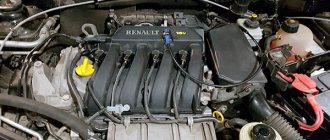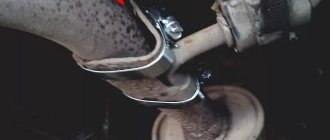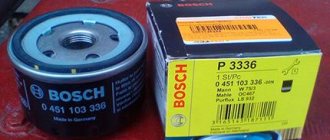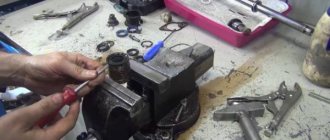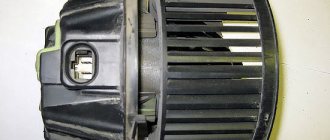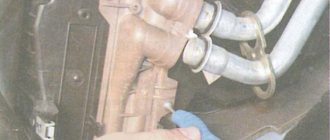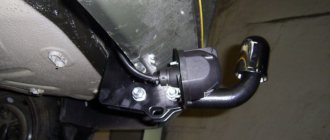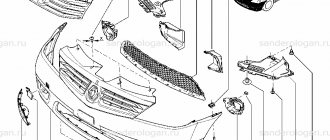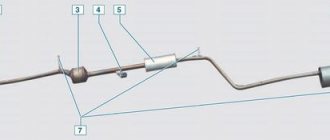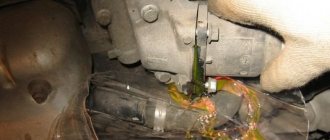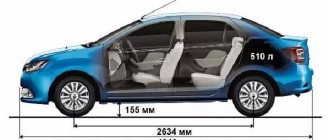In the K7M engine, between the edge of the valve base and the adjusting bolt itself, which is inserted into one of the edges of the so-called rocker arm of the valve drive, there is a special clearance that allows you to compensate for the thermal expansion of the valve.
For the K7M engine, valve adjustment is essential. If the mentioned gap becomes too large, then the valve will not open fully, and if it is too small, it will not close.
Before starting the adjustment, it is advisable to make sure that the timing belt tension is in order.
What does valve adjustment do?
Valve clearances are the distance between the adjusting bolt and the drive rod.
Renault specialists leave gaps to compensate for thermal expansion of the metal parts of the gas distribution mechanism. Incorrectly adjusted valves accelerate wear of parts. With increased valve clearance, engine power decreases - the cylinder is not filled with fuel sufficiently.
Reduced valve clearance leads to a loss of combustion efficiency of the fuel mixture due to incomplete compression. The saddles may burn and carbon deposits may appear. Subsequently, timing belt repair will be required.
A car engine operates in a difficult thermal regime, so its parts are subject to thermal expansion. The presence of a gap between the valve stem and the lever ( rocker arm) allows you to compensate for changes in linear dimensions. However, it should not be too large, otherwise the valve will not open completely. The cylinders will be less well filled with the combustible mixture, and the exhaust gases will not be able to leave the combustion chamber in time. As a result, the engine does not develop full power, and fuel consumption increases.
If the clearance is insufficient, the valve will not close, which again entails a loss of power, unstable operation of the power unit and increased gasoline consumption. And if such a nuisance does not entail unpleasant consequences for the intake valves, then the exhaust valves and their seats operating in more difficult conditions are subject to catastrophically rapid wear.
According to the manufacturer's recommendations, the gap for the intake valves (they are located on the side of the air manifold) is 0.1-0.15 mm, and for the exhaust valves - 0.25 - 0.3 mm . If the procedure is carried out after replacing parts of the gas distribution mechanism, then a gap of 0.2-0.25 mm is left for the new exhaust valves. After their plates are worn in to the saddles, the parameters will return to normal.
What are the gaps for?
In order to compensate for the thermal expansion of the metal in the gas distribution mechanism system, technological tolerances are set between the drive rod and the adjusting bolt.
Any deviations from the norms lead to increased wear of parts.
A distinct knocking sound in the engine compartment at idle loudly informs the owner of the need to adjust the clearances.
An increasing mismatch in size will not allow the valve to open completely, and, as a result, the cylinder will not be filled well with the dose of the combustible mixture and the engine power will drop.
With a reduced gap, efficiency is also lost due to incomplete compression, the seats burn and carbon deposits appear, which may lead to unplanned timing repairs.
The adjustment must be carried out on a cold engine.
Metal expands under the influence of heat, which is taken into account when developing any complex components. Compensation for such expansion is also necessary in the timing mechanism of the 1.4 liter Renault Logan engine, which can be achieved due to special tolerances between the adjustment bolt and the drive rod. Deviation of the gap from the specified parameter leads to accelerated wear of parts.
The first evidence of problems with Logan valves is the appearance of engine knocking at idle. In such a situation, it is recommended to adjust the gaps and adjust them according to the manufacturer's recommendations. The consequences of deviation can be fatal for the power unit:
- Exceeding the parameter leads to the impossibility of normal operation of the valve - it fails to open normally, which is why an insufficient volume of the fuel-air mixture enters the combustion chamber. The result is a decrease in the efficiency of the 8-valve engine.
- A decrease in the indicator also leads to a drop in power due to insufficient compression. In addition, under such circumstances, the valve burns, carbon deposits appear on its seat, which requires restoration of the timing belt. Timely adjustment of the valve mechanism on Logan allows you to avoid such problems.
To properly adjust the clearances, it is recommended to perform all activities on a cold engine.
Measurements are made using special probes.
This is interesting: Kia Spectra safety block (Kia Spectra): diagram, location of blocks
As a result, the result of a regulation violation may be:
- Rapid failure of the Renault Logan engine mechanism.
- Reducing the power of the power unit.
- Loss of engine efficiency due to incomplete combustion of the fuel mixture in the combustion chamber.
- The appearance of soot and other problems.
Ignoring a malfunction inevitably leads to increased costs associated with the need for expensive repairs.
When to adjust valves
The manufacturer recommends adjusting the Renault Logan valves after 80–100 thousand kilometers. In practice, adjustment is required after 60,000 km.
On Renault Logan with gas fuel instead of gasoline, the saddle fails faster.
The frequency of adjustment of Logan valves with LPG is reduced to 30,000 km.
You should think about adjusting the valves if you experience a distinct knocking sound at idle. The knock should come from the engine compartment.
Frequency of regulatory activities
According to the manufacturer's recommendations, the gaps between the levers and valve stems should be adjusted every 80 thousand mileage of the car. As practice shows, you have to do engine maintenance much earlier - as soon as the numbers on the speedometer pass the 60 thousand km mark. If you operate Renault Logan with gas-cylinder equipment, then the frequency of adjustment is halved. Every 30 thousand km you will have to call in for service and waste time and money. Or do it yourself - the adjustment procedure is simple and even novice car enthusiasts can do it.
Necessary tools and knowledge
- pliers;
- set of probes;
- open-end wrench set to “13”;
- wheel wrench set to “10”;
- screwdriver.
The frequency of adjustment, as recommended by the manufacturer, is every 100,000 km. But practice shows that these figures should be reduced to 60 thousand km. It is worth noting: using gas as fuel makes the saddle seat faster, so in this case experts advise adjusting the dimensions every 30 thousand kilometers.
The clearance standards are within:
- inlet – 0.10-0.15 mm;
- graduation – 0.25-30 mm.
When completely replacing the exhaust valves with new ones, you need to set 0.2-0.25 mm for grinding.
Owners of Renault Logan must carry out routine adjustment of the valve system after every 100 thousand km, regardless of whether there are 8 valves or 16 in the engine. However, most experts do not agree with this frequency. They believe that valve adjustments should be performed more often, every 60 thousand km. Drivers with extensive experience in using Renault Logan say that driving on gas instead of gasoline has a negative effect on the valves. First of all, saddle subsidence is observed. Gas is released into the chamber rather than fuel due to incorrect clearances that have arisen.
Specialists at VIP-class car services perform adjustments to the Renault Logan valve system every 30 thousand km, regardless of the engine rating, 1.4 and 1.6.
When carrying out such repairs, it is necessary to remember the standards for clearances. These are the values:
- Intake valve clearances range from 0.1mm to 0.15mm;
- Exhaust valves must have a clearance of 0.25 mm to 30 mm.
If new exhaust valves 8 or 16 are installed, then the gap should be increased so that they can undergo grinding. In this case, the range changes to 0.2-0.25 mm
Engine repair prices
| Job | Price |
| Remove the engine / install the engine | from 9700r. |
| Remove the engine | from 4800 rub. |
| Replace and install the engine | from 6800 rub. |
| Engine repair | from 14800 rub. |
| Engine overhaul | from 9700r. |
| Replacing the cylinder head (cylinder head) | from 4200 rub. |
| Replacing the cylinder head gasket | from 4200 rub. |
| Replacing the camshaft oil seal | from 1000 rub. |
| Replacing the valve cover gasket | from 300 rub. |
| Replacing valve stem seals on a removed cylinder head | from 2200 rub. |
| Replacing valves | from 2700 rub. |
| Replacing intake valves | from 2300 rub. |
| Replacing exhaust valves | from 2300 rub. |
| Replacing valve guides | from 2700 rub. |
| Replacing the valve seat | from 2700 rub. |
| Crimping of the cylinder head | from 1000 rub. |
| Grinding the plane of the cylinder head | from 900 rub. |
| Replacing the front crankshaft oil seal (kv) | from 1000 rub. |
| Replacing the rear crankshaft oil seal (kv) | from 600 rub. |
| Replacing spark plugs for a gasoline engine | from 600 rub. |
| Replacing the timing belt | from 3300 rub. |
| Replacing the drive belt | from 700 rub. |
| Replacing the engine mount (internal combustion engine) | from 1000 rub. |
| Replacing the intake manifold gasket | from 1000 rub. |
| Replacing the throttle valve | from 600 rub. |
| Replacing the exhaust manifold gasket | from 1000 rub. |
| Replacing a gasoline/diesel engine turbine | from 2300 rub. |
| Flywheel replacement | from 4700 rub. |
| Replacing two mass flywheels | from 6700 rub. |
| Replacing the engine cooling system water pump | from 4300 rub. |
| Replacing the engine cooling radiator | from 1500 rub. |
| Engine diagnostics | from 600 rub. |
| Replacing the engine pan gasket | from 2300 rub. |
| Replacing the engine sump | from 2300 rub. |
| Replacing the timing chain without removing the internal combustion engine | from 6800 rub. |
| Engine sump repair | from 1000 rub. |
| Replacing a diesel engine - remove / install the engine | from 9800r. |
| Replacing a diesel engine - remove the diesel engine | from 5800 rub. |
| Replacing a diesel engine - install a diesel engine | from 7700 rub. |
| Diesel engine - remove/install engine | from 9800r. |
| Replacing the timing chain of a diesel engine without removing the internal combustion engine | from 11800r. |
| Replacing the timing belt of a diesel engine without removing the internal combustion engine | from 6900 rub. |
| Diesel engine diagnostics | from 1100 rub. |
| Repair of the cylinder head of a gasoline engine | from 2400 rub. |
| Diesel engine repair | from 19500 rub. |
| Repair of the cylinder head of a diesel engine | from 4850 rub. |
How to adjust valves
Valve adjustment is carried out only on a cold engine! Before adjusting, it is necessary to tighten the timing belt if it is loose.
What standards should we follow?
It was previously noted that it is advisable to make adjustments (including the 1.4 liter Logan engine) “cold”. Before starting work, it is advisable to adjust the timing belt if its tension is insufficient.
To correctly adjust the mechanism, you should look in advance at the car manual and look at the clearance standards recommended by the manufacturer:
- Intake valve - 0.1-0.15 mm.
- Release valve - 0.25-0.3 mm.
If parts are completely replaced, a gap of 0.2-0.25 mm is set for grinding purposes.
Instructions (photo report) for adjusting valves on Renault Logan
The self-adjustment procedure requires removing the cylinder head cover. Before you start, you need to prepare the tool.
- Unscrew the 4 bolts securing the air filter.
- Remove the L-shaped pipe that goes from the filter element to the valve cover.
- Remove the air filter housing.
- Disconnect spark plug wires.
- Unscrew the 8 bolts securing the valve cover.
- Raise the front of the vehicle on the driver's side.
- Engage 4th gear.
- Rotate the raised wheel until the letter F appears on the camshaft gear. Watch the valve of the first cylinder - the letter appears almost immediately after the valve begins to move when the wheel rotates. One wheel revolution is equal to one camshaft revolution.
- Measure the valve clearances of the first cylinder. You need to loosen the locking nut and tighten the bolt with pliers. The gap is checked using a feeler gauge.
- Tighten the lock nut after setting the required gap and check again with a feeler gauge.
- Adjust the clearance of the second valve of the first cylinder.
- Rotate the crankshaft half a turn and adjust the valve clearances of the third cylinder.
- Rotate the crankshaft half a turn and adjust the valve clearances of the fourth cylinder.
- Rotate the crankshaft half a turn and adjust the clearances of the second cylinder.
This is interesting: Replacing the main brake cylinder on a VAZ-2110: checking, repairing the GTZ
When starting engine maintenance, be sure to check and adjust the timing belt tension. We remind you that checking and setting clearances is carried out only on a cold engine. Otherwise, the parameters are overestimated, which is why you will get an unpleasant knock and will be forced to redo everything. For work you will need:
- a set of flat probes;
- open-end wrench “13”;
- tubular wrench or socket to “10”;
- screwdriver;
- pliers;
- jack.
- Remove the air filter housing. To do this, disconnect the corrugated air duct pipe and remove the 4 fastening screws.
- Rocking the filter element assembly left and right, remove it from its place and lift it from the side of the right wheel (hereinafter, the standard orientation in the direction of travel of the car is used). By sticking your hand into the resulting opening, release the plastic adsorber tube from the holders. There, remove the breather hose from the fitting located on the valve cover. After this, set the air filter housing aside.
- Remove the ends of the high-voltage wires from the spark plugs, disconnect the ignition module connector and the thin crankcase ventilation hose. Next, move aside the adsorber hose and the wiring harness, which is located at the right end of the valve cover.
- Having gained access to the upper part of the power unit, you should thoroughly blow all places with compressed air. In the future, this will prevent dust and debris from reaching the open gas distribution mechanism.
- Using a tubular wrench, unscrew the valve cover and remove it from the engine. If necessary, the parts installed on it are dismantled, and the part is washed.
- With the car on the parking brake, engage fifth gear. After this, use a jack to hang the right front wheel. This technique will allow you to rotate the camshaft during adjustments.
- The clearances of the engine intake and exhaust valves are adjusted according to the same scheme, so let’s look at the features of this process using the example of the 4th cylinder. The first thing is to ensure maximum clearance between the adjusting bolt and the valve stem. Slowly turning the suspended wheel, control the moment when the camshaft cam moves away from the working part of the lever (rocker) to the maximum distance.
- Check the clearance between the timing lever adjusting bolt and the end of the valve. To do this, insert a probe of the required thickness into the place of their contact. We remind you that the manufacturer recommends a gap of 0.1-0.15 mm for intake valves, and 0.25-0.30 mm for exhaust valves. A tool entering without effort is evidence of an increased gap - because of it, an unpleasant knock is heard when the engine is running. If the probe enters with difficulty or does not enter, then this indicates that the gap is too small - the valve is “clamped”. And finally, a slight tightness at the point of contact of the feeler gauge with the rocker plane on one side and the end of the valve stem on the other is normal - the clearance is adjusted correctly.
- Having found out with the help of a probe that the parameters recommended by the manufacturer are violated, proceed with the adjustment. To do this, use a spanner or open-end wrench “13” to completely loosen the lock nut of the adjusting bolt.
- If the car's mileage is 150-200 thousand km, inspect the mating parts. To do this, unscrew the bolt and inspect the end part. If there is wear, replace it, since the gap cannot be adjusted in this case. In addition, inspect the threads on the parts of the adjusting unit and draw conclusions about their suitability for further use.
- While holding the locknut from turning, rotate the bolt in the desired direction. It is most convenient to do this with a special tool, but if you don’t have one, use pliers. The rocker arm has a right-hand thread, so to increase the gap, turn the screw to the left, and to decrease it, turn it clockwise.
- Having achieved a position of the valve mechanism parts in which the dipstick can be moved with little effort, tighten the locknut. This must be done carefully, holding the adjusting screw itself from turning. Be sure to take into account that during final tightening the bolt rises upward by hundredths of a millimeter, so it is better to make a small adjustment.
- After removing the dipstick, press the rocker arm several times. After this, check the accuracy of the adjustment again.
- Periodically turning the camshaft by rotating the suspended wheel, check and, if necessary, adjust other valves.
- When starting assembly, inspect the valve cover gasket. Replace the heavily compressed part with a new one. In this case, it is better to use metal sealing elements - paper gaskets have not proven themselves to be the best.
- Return the valve cover to its place. After installing the bolts and screwing them in by hand to the maximum depth, proceed to fixing. As with other similar parts, tightening is carried out in several approaches, in a cross-shaped pattern from the center to the periphery. It is better to control the force using a torque wrench - this will ensure reliable fastening and safety of the thread.
- Replace the previously removed wiring harness and adsorber tube. After this, connect the hose from the intake manifold (thin breather) to the valve cover and install the ignition module if it was removed to clean it.
- Replace the air filter housing and attach the crankcase ventilation pipe and corrugated air duct hose to it. After this, proceed with the test run. After starting the engine, there should be no extraneous noise or knocking in its operation. Smooth operation in various operating modes and the absence of vibration at idle speed indicate that the adjustment has been made correctly.
This is interesting: Tow trucks for cars
Engine Renault Logan 1.4 l 8 valves (k7j)
The first generation Renault Logan is equipped with an eight-valve 1.4-liter engine (k7j).
Let's consider its technical characteristics and design features.
Technical characteristics of the Renault Logan engine 1.4 liters, 8 valves (k7j)
Engine model - K7J
Engine type - gasoline, four-stroke, four-cylinder, in-line, eight-valve
Location - transverse
Timing drive - belt (replacement after 60 thousand km)
Power system - distributed fuel injection (each cylinder has a separate injector)
Cylinder diameter and piston stroke - 79.5 X 70 mm
Displacement - 1390 cm³ (1.4 liters)
Compression ratio - 9.5
Engine power - 75 l/s (55 kW) at a crankshaft speed of 5500 rpm
Maximum torque - 112 N.m (at 3000 rpm)
Fuel used: Unleaded gasoline with an octane rating of at least 91 (Ai-92, Ai-95)
Engine control system (ECM) - electronic (ECU Siemens, Continental)
The ignition system is electronic, part of the engine management system (a spark is supplied to two cylinders at once: 1-3 or 4-2)
Lubrication system - combined (main and connecting rod bearings of the crankshaft and camshaft bearings are lubricated under pressure, other components are lubricated by splashing)
Cooling system - forced (pump) with two cooling circles (large and small)
The engine crankcase ventilation system is forced, with the passage of gases through an oil separator in the valve cover (has two branches: small and large)
Toxicity standards - Euro-2, since 2007 Euro-3
Design features of the Renault Logan 1.4 l engine
The operating order of the cylinders is 1-3-4-2 (cylinders count from the gearbox)
Cylinder block - cast iron
Cylinders - machined into a block
Crankshaft - five main and four connecting rod journals
Pistons - aluminum alloy, piston pin pressed into the connecting rod head
Piston rings - two upper compression rings, lower oil scraper
The block head is aluminum, mounted on a metal gasket, centered with two bushings, secured with ten bolts, with an aluminum cover
Camshaft - mounted on the cylinder head on five supports, driven from the crankshaft by a timing belt (if the valve belt breaks, it bends)
Valves - two valves per cylinder, rocker arm drive (one edge of the rocker arm rests on the camshaft cam, the other on the adjusting screw - screw for adjusting the thermal clearances of the valves)
The oil pump is gear-type, mounted in a sump to the cylinder block, chain driven from the crankshaft
Oil filter - full-flow, non-separable, replaced along with an oil change (15,000 km)
Notes and additions
— In addition to the 1.4 liter k7j engine, the first generation Renault Logan car is equipped with an 8-valve 1.6 liter k7m engine. It is similar to the k7j, but has a volume increased to 1.6 liters (due to a larger piston stroke in a taller cylinder block).
More articles on the 8-valve engine Renault Logan 1.4 l (k7j) NGK spark plugs in the ignition system of the Renault Logan car engine Replacing the pump tube of the k7j Renault Logan engine Selecting engine oil for the k7j 1.4 l and k7m 1.6 l engines of the Renault Logan car Replacement Valve cover gaskets for the 1.4 k7j engine of the Renault Logan car Replacing the pump on the 1.4 Renault Logan engine
Useful tips
To make the process of adjusting Renault Logan valves simpler and more efficient, you should follow simple recommendations:
- After the cover is removed, you need to find a special mark made with enamel paint. This will help determine if the cylinder is in the proper position. If the mark is pointing up, the cylinder is at top dead center. You can move the mark to the desired position by rotating the hanging wheel.
- Every half revolution of the right wheel moves a certain cylinder to the desired position. When turning the wheel in the direction of travel of the car, the first, fourth, second and third cylinders are sequentially adjusted. The calculation starts from the flywheel side.
- You can make sure that the piston is in the right position by unscrewing the spark plug and testing it with an aluminum wire.
TDC of the first cylinder
It is necessary to adjust the camshaft so that the piston of the first cylinder is at TDC. The camshaft cams must be positioned accordingly so that both valves are closed. This will be the moment of compression. That is, the cams should be positioned with their protrusions down; the rocker arms will be free and will not put pressure on the valves.
You can check the correct position by looking at the camshaft pulley. Mark F will be located approximately as in the photo.
More precisely, the piston is adjusted to TDC by touch using a screwdriver or a thin metal rod. If you insert a rod into the spark plug hole and turn the engine from back to front. The maximum output of the rod will be the required position of the piston at TDC. In this position, the valves of the first cylinder are adjusted.
